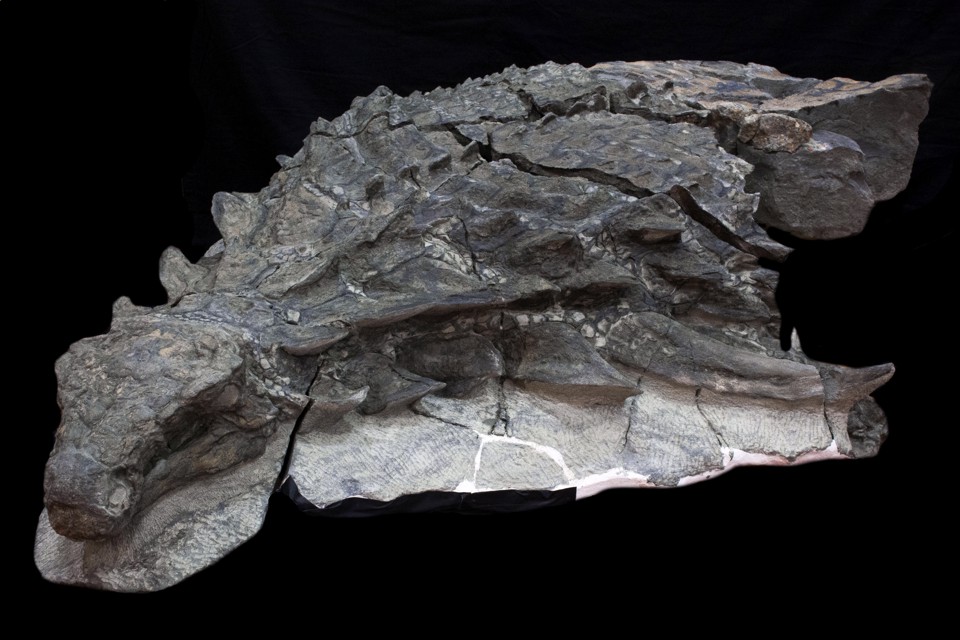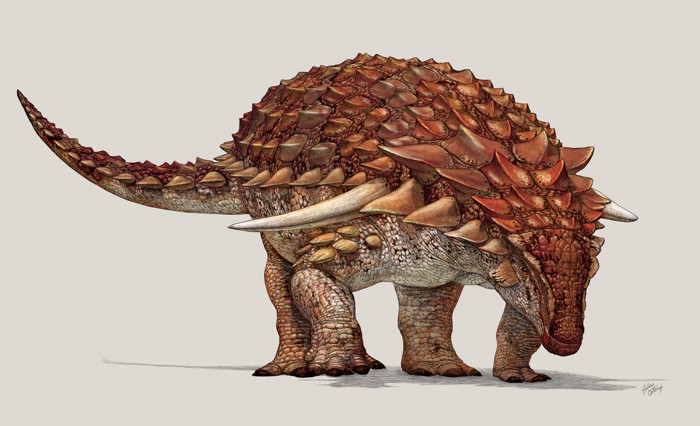| Topic: Canadian top dinosaur fossil find | |
|---|---|
|
In March 2011, a construction worker named Shawn Funk visited an impressive dinosaur collection at the Royal Tyrrell Museum in Alberta. As he walked through halls full of ancient bones, he had no idea that a week later, he’d add to their ranks by finding one of the most spectacular dinosaur fossils of all time. It’s an animal so well preserved that its skeleton can’t be seen for the skin and soft tissues that still cover it.
 When we look at dinosaurs in museums, it takes imagination to plaster flesh and skin on top of the bones. But for the dinosaur that Funk unearthed—a 110-million-year-old creature named Borealopelta—imagination isn’t necessary. It looks like a sculpture. And based on pigments that still lurk within the skin, scientists think they know what colors the animal had. “If someone wants to come face to face with a dinosaur, and see what it actually looked like, this is the one for that,” says Caleb Brown from the Royal Tyrrell Museum, who has studied the animal.  Royal Tyrrell Museum of Palaeontology Borealopelta was one of the ankylosaurs—a group of heavy-set, low-slung, tank-like dinosaurs. It lacked the shin-thwacking tail clubs that some of its relatives wielded, but its back was covered in heavy, armored scales, and a pair of 20-inch-long spikes jutted from its shoulders. It weighed 1.5 tons and was 20 feet from foot to tail. And it probably couldn’t swim very well. Somehow, this particular individual ended up at sea. Perhaps it got careless on a shoreline. Perhaps it drowned in a flood and was washed out to sea. Either way, gases started building up in its body, causing it to float belly-up. As those gases released, the dead dinosaur sank, and hit the ocean floor hard enough to leave a small crater. Before sharks had a chance to nibble it, or worms had a chance to bury into its bones, it was quickly smothered by fine sediment and sealed off from the outside world. There it remained for millions of years, until March 11, 2011, when an excavator bit into it. By then, the ocean floor that had swallowed the dinosaur had become the Millennium Mine—a huge oil sand quarry in northern Alberta. Funk, a heavy-equipment operator, was digging in the mine when he noticed a change in the texture and color of the underlying rock. Alberta is rich in fossils, and construction crews know that any dig could potentially yield fresh bones. Funk called his supervisor, and they alerted the Royal Tyrrell Museum. Two days later, Donald Henderson and Darren Tanke flew over, expecting to find the bones of a marine reptile—a long-necked plesiosaur, perhaps, or a dolphin-like ichthyosaur, fossils of which are commonly found in Alberta. But on arrival, they realized that the miners had actually uncovered something special—a dinosaur. Excavators had already smashed through the animal’s tail and rear end, which were permanently lost. But most of the creature was still there, and even then, it was clear that it had rare features like fossilized skin. “I don’t think anyone realized how magnificent the specimen was going to be,” says Brown. After three days of intense safety training, the team began to liberate the dinosaur—a process that took two weeks of laborious 12-hour shifts. “All the mine staff from every level and department were tripping over themselves offering to help,” Henderson later wrote in The Guardian. They eventually isolated a single 15,000-pound block that contained the animal, and that was jacketed in burlap and plaster. But as they lifted the block, the jacket split and the block collapsed—a horrifying moment, immortalized on video. Fortunately, everything broke cleanly and in big pieces, all of which were shipped to the museum. One might think that a large team would process the fossil, but the museum’s team of a dozen technicians is already stretched thin. Every year, Alberta discovers more dinosaur specimens than the Royal Tyrrell can possibly collect, so many are just left in the ground. Of those that are recovered, many linger in warehouses. The ankylosaur clearly deserved special attention, but because of its delicate state, it was assigned to a single pair of steady hands. Those hands belonged to technician Mark Mitchell, who compares the process of separating dinosaur from rock to chipping concrete chunks from a surface as soft as compressed talcum powder. It took him 7,000 hours over 5.5 years, during which he did little else. For that reason, the dinosaur carries his name—Borealopelta markmitchelli. (The first half comes from the Latin for “northern shield.”) more here |
|
|
|
|
|
This must be the one I heard mention of yesterday.
Amazing the conditions that had to be for it's excellent preservation. |
|
|
|
|








